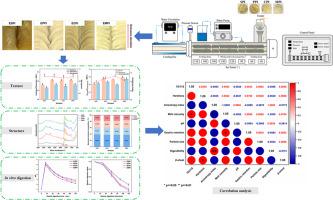High moisture extrusion of pulse proteins: Texture, structure, and in vitro digestion characteristics of extrudates
IF 11
1区 农林科学
Q1 CHEMISTRY, APPLIED
引用次数: 0
Abstract
Pulse proteins are promising components for plant-based food development, yet their diverse subunit compositions, influenced by source origin, result in variable extrusion properties. This study utilized high moisture extrusion (60% moisture content) to prepare extrudates from four pulse proteins: soy, pea, chickpea and mung bean protein isolates (SPI, PPI, CPI, and MPI, respectively). The texture, structure, and in vitro digestion characteristics of extrudates were examined. The results showed that SPI and PPI were mainly composed of 7S and 11S globulins, while CPI and MPI were mainly composed of 7S globulins, and 11S globulins, respectively. SPI extrudates exhibited significantly lower hardness, chewiness, and transverse and longitudinal fracture stresses, while CPI extrudates exhibited a higher anisotropy index. SPI extrudates with a higher β-sheet content (39.08%) exhibited denser structures. The gastrointestinal digestibility (86.65%) of CPI extrudates was higher than other groups. Correlation analysis showed that 7S/11S ratio was positively correlated with the melt viscosity, while negatively correlated with the anisotropy index and in vitro digestibility. This study highlights the distinct extrusion properties of pulse proteins based on their unique subunit composition. The results provide insights for selecting appropriate protein sources and developing plant-based protein products with tailored textural attributes and desirable digestibility.

高水分挤压脉冲蛋白质:挤出物的质地、结构和体外消化特性
豆类蛋白质是植物性食品开发中很有前景的成分,但由于其亚基组成受来源影响而各不相同,导致挤压性能也各不相同。本研究利用高水分挤压法(含水量为 60%)制备了四种豆类蛋白的挤压物:大豆、豌豆、鹰嘴豆和绿豆分离蛋白(分别为 SPI、PPI、CPI 和 MPI)。研究了挤出物的质地、结构和体外消化特性。结果表明,SPI 和 PPI 主要由 7S 和 11S 球蛋白组成,而 CPI 和 MPI 分别主要由 7S 球蛋白和 11S 球蛋白组成。SPI 挤压物的硬度、咀嚼性、横向和纵向断裂应力明显较低,而 CPI 挤压物的各向异性指数较高。β-片材含量较高(39.08%)的 SPI 挤压物表现出更致密的结构。CPI 挤压物的胃肠道消化率(86.65%)高于其他组别。相关分析表明,7S/11S 比率与熔体粘度呈正相关,而与各向异性指数和体外消化率呈负相关。这项研究强调了脉冲蛋白质因其独特的亚基组成而具有不同的挤压特性。研究结果为选择合适的蛋白质来源、开发具有定制质构属性和理想消化率的植物性蛋白质产品提供了启示。
本文章由计算机程序翻译,如有差异,请以英文原文为准。
求助全文
约1分钟内获得全文
求助全文
来源期刊

Food Hydrocolloids
工程技术-食品科技
CiteScore
19.90
自引率
14.00%
发文量
871
审稿时长
37 days
期刊介绍:
Food Hydrocolloids publishes original and innovative research focused on the characterization, functional properties, and applications of hydrocolloid materials used in food products. These hydrocolloids, defined as polysaccharides and proteins of commercial importance, are added to control aspects such as texture, stability, rheology, and sensory properties. The research's primary emphasis should be on the hydrocolloids themselves, with thorough descriptions of their source, nature, and physicochemical characteristics. Manuscripts are expected to clearly outline specific aims and objectives, include a fundamental discussion of research findings at the molecular level, and address the significance of the results. Studies on hydrocolloids in complex formulations should concentrate on their overall properties and mechanisms of action, while simple formulation development studies may not be considered for publication.
The main areas of interest are:
-Chemical and physicochemical characterisation
Thermal properties including glass transitions and conformational changes-
Rheological properties including viscosity, viscoelastic properties and gelation behaviour-
The influence on organoleptic properties-
Interfacial properties including stabilisation of dispersions, emulsions and foams-
Film forming properties with application to edible films and active packaging-
Encapsulation and controlled release of active compounds-
The influence on health including their role as dietary fibre-
Manipulation of hydrocolloid structure and functionality through chemical, biochemical and physical processes-
New hydrocolloids and hydrocolloid sources of commercial potential.
The Journal also publishes Review articles that provide an overview of the latest developments in topics of specific interest to researchers in this field of activity.
 求助内容:
求助内容: 应助结果提醒方式:
应助结果提醒方式:


